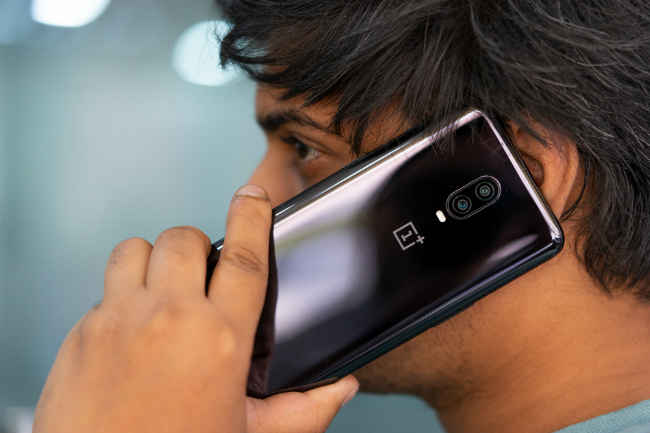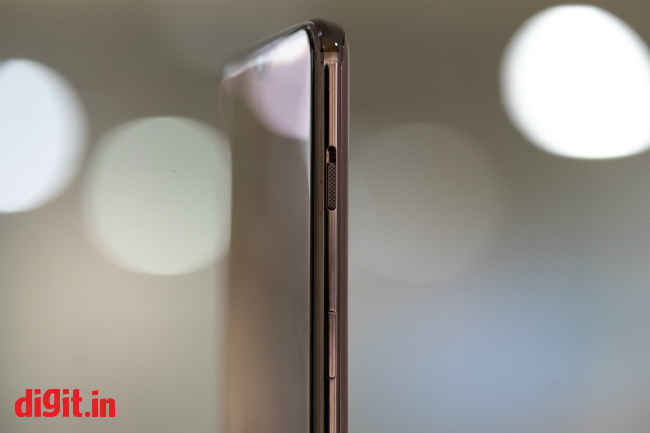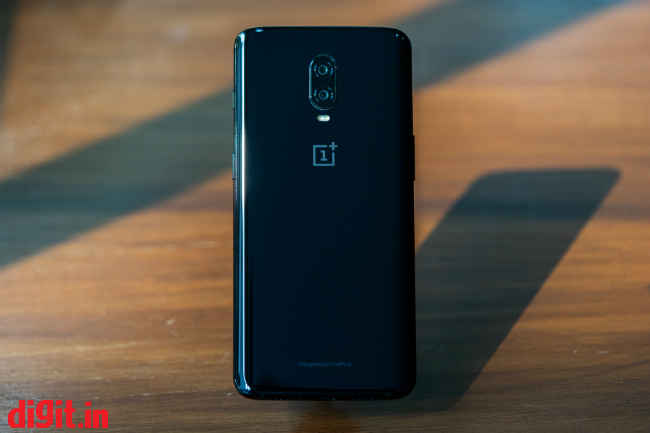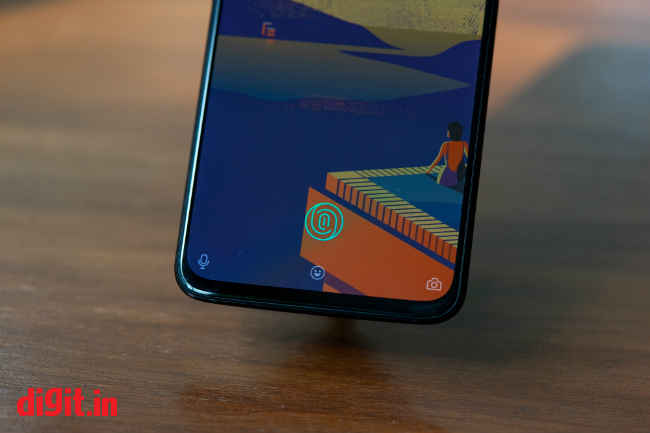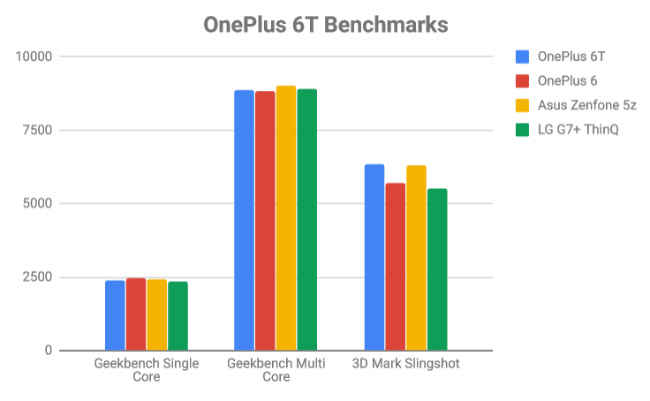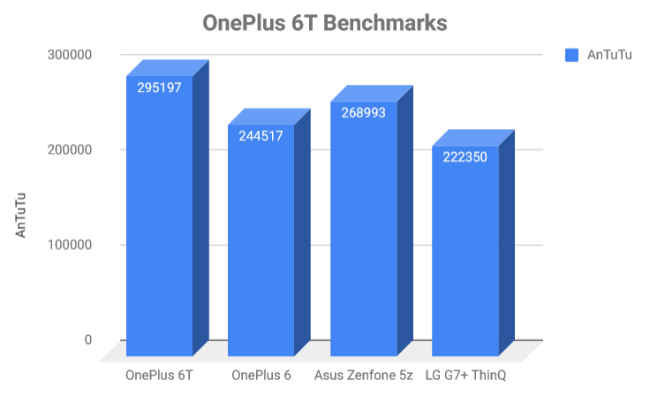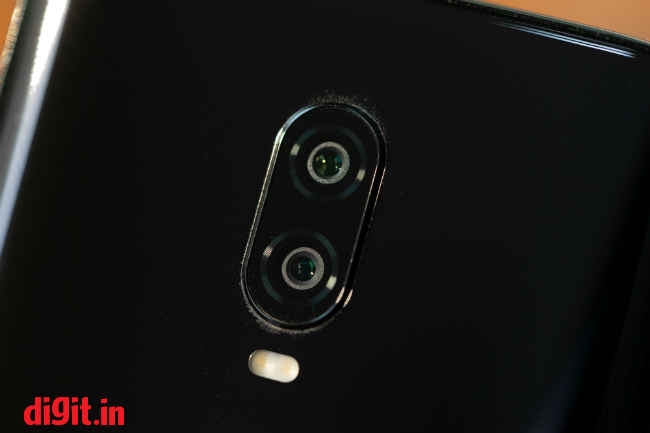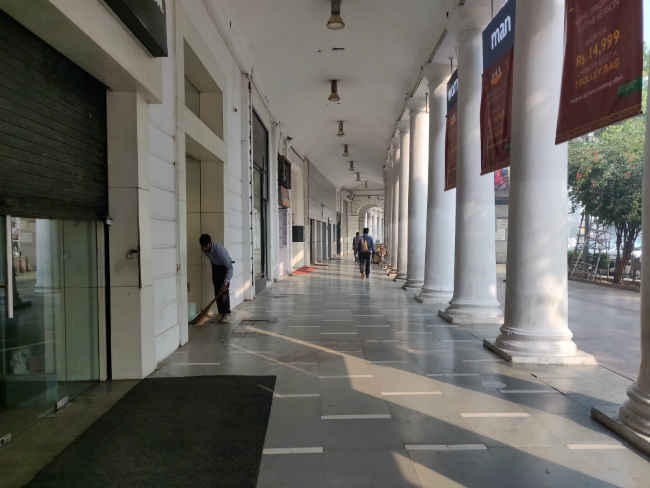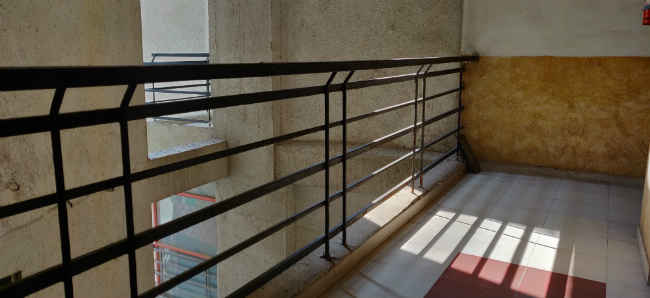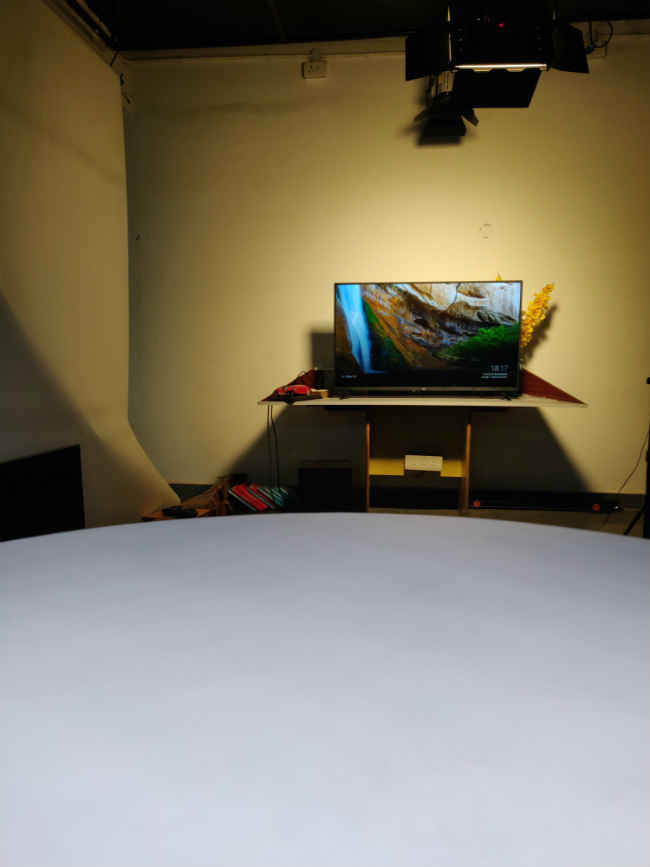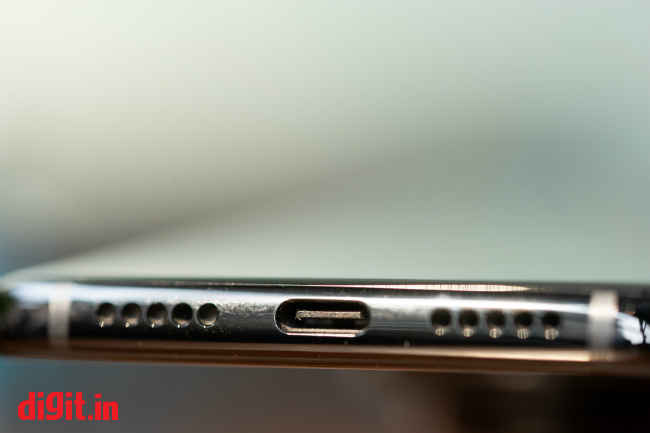OnePlus 6T Review : No longer a budget flagship
The OnePlus 6T is basically the OnePlus 6 with a smaller notch, bigger battery and an in-display fingerprint sensor. It doesn’t make sense for the present users for the OnePlus 6 to upgrade at all, but if you’re on an older OnePlus phone, this one is something to look out for. The 64GB variant is no longer offered by the company, so the base price is now higher. It’s also all about pure speed which no other Android flagship comes close to. It is only the Apple devices that seem to be faster in both benchmarks and daily use, but they cost more than twice the price of the OnePlus 6T. However, if you’re planning to purchase a high-end phone mostly for gaming, you could save your money and buy the Poco F1. If you’re looking for high-end smartphone with an excellent display and incredible audio output, the LG G7+ ThinQ is the one to get. The OnePlus 6T is a sensible upgrade for those who need the incredible speed and the amazing battery life, along with being okay with having ‘above-average’ of everything else. It’s not at all disappointing a disappointing smartphone, but definitely lacks some of the bells and whistles found on other smartphones at this price, such as the LG G7+ ThinQ. OnePlus is no longer the only one playing the flagship killer game, and that is a great thing for us, the consumers.
The OnePlus 6T takes the almost bezel-less panel and takes it up a notch. The display cutout now takes up the size of a water droplet. The OnePlus 6T also did away with the fingerprint sensor on the back and put it under the display. Why, you may ask? Because that’s what is trending that’s why. While the OnePlus 6T is an evolutionary step up from the OnePlus 6, it also feels like something reactionary. Could it be that OnePlus simply wanted to be among the first few companies to implement a technology that’s not nearly as perfect as the one it’s replacing? Quite possible.
Even more than being reactionary, the OnePlus 6T also faces a threat it itself helped create in the form of other flagship killers (and even out and out flagships) offered at prices same or even lower than it. While it’s easy to just look at the OnePlus 6 and comment what has improved in the OnePlus 6T, the market is much bigger, even though OnePlus is being hailed as the numero uno in the premium segment. Keeping that in mind, let’s begin.
Design
One way to sum up the OnePlus 6T is by borrowing lines from the late Steve Jobs. “Don’t fix what ain’t broken.” The OnePlus 6T looks ditto like the OnePlus 6 until you look closer. Incremental changes is the running theme of the device, and in the design aspect, the OnePlus 6T is a bit thicker and heavier, while the bezels around the display have been shaved off even more. The most obvious changes (I’m not calling them upgrades), are the notch which has shrunk in size and the fingerprint sensor being removed. The rest of the design is just the same as the OnePlus 6.
3D glass on the back delivers a polished feel to the device. It tapers gently around the edges offering a better grip. The horizon line OnePlus loves to talk about is also maintained and you can see the shiny white line if you hold the device at eye-level. The camera bump is now slightly lesser, as compared to the OnePlus 6, and the OnePlus logo has shifted up taking the place of the fingerprint sensor. The aluminium frame is quite study and you’ll have to apply a lot of force to bend this phone. The button arrangement is also the same and you do get the alert slider which shifted to the right since the OnePlus 6. For a right-handed user, it’s perfectly handy, but for someone left-handed (like me), it needs some finger acrobatics to reach and operate. It still doesn't have an IP rating, even though the LG G7+ ThinQ, a close competitor has both IP68 waterproofing and Mil-Spec rated durability.
Up front is the display that takes up 85.6 percent of the body with almost negligible bezels on the sides. The screen is strengthened with Corning Gorilla Glass 6 and is one of the first smartphones in India to do so. Also, in a bid to fit a bigger battery and the in-display fingerprint sensor, the 3.5mm headphone jack was given the boot. That makes the OnePlus 6T the latest in a long line of other smartphones to do the same, and frankly, it’s infuriating. Headphone jacks are still needed, at least in a country like India which is one of the most profitable markets for OnePlus. You do get a dongle in the box, but that can be easily misplaced or worse, broken. Fact of the matter is that to make full use of the OnePlus 6T, you will either have to invest in a USB-Type C earphones (which restricts its versatility) or a pair of wireless headphones (which has its own problems including a limited amount of battery life).
Also, after using the OnePlus 6 as a daily driver ever since its launch, I kept reaching out to the back of the phone to unlock the phone for the first few days. I’m guessing it’ll be the same for OnePlus 5T users as well since that was the first time OnePlus shifted the sensor to the back.
These little niggles aside, the OnePlus 6T is quite intricately built. If you leave out the lack of the headphone jack, the OnePlus 6T is just as sturdy and sexy as the OnePlus 6, although keeping it looking pristine is a task. It will only be offered in two black colour variants — Midnight Black and Mirror Black, for now, which OnePlus claims has been the most selling variant of the OnePlus 6. We received the Mirror Black variant of the smartphone, and just like its predecessor, it’s quite the smudge magnet. Sweat marks, fingerprints, grease — Everything sticks to it like moths on lamps and it isn’t quite easy to remove them. The midnight black variant has a matte-like texture that does away with most of those issues.
Despite everything, I do like the OnePlus 6T’s design. It feels good in the hand. The added weight also helps in using the phone with one hand. In all, the OnePlus 6T feels just as premium as the other flagships, something that cannot be said about the Poco F1.
Display
The OnePlus 6T incorporates a larger 6.41-inch Optic AMOLED display which is both bigger and visibly better than the one on the OnePlus 6. Now better is subjective, but the OnePlus 6T’s panel does look a lot richer and more vibrant than the one on the OnePlus 6. The OnePlus 6 in turn improved the panel over the OnePlus 5T, so if you’re planning to upgrade to the OnePlus 6T, you will be better off. The display is bigger primarily because of the smaller notch on the phone. It’s much more bearable than what was on the OnePlus 6, but it’s still quite intrusive. The notch is now shaped as a water drop instead of a valley, leaving a lot of space on top for the status bar icons. One of my colleagues really hated the OnePlus 6 for hiding essential information like internet speed within the drop-down menu, and even though OnePlus 6T had enough space to show it on the status bar, OxygenOS decided to keep it as it is, which is a bummer. The smaller notch means things had to be removed and OnePlus chose to give the LED notification light the boot. While I personally don’t care much about the LED light considering the always-on display more than makes up for it, people are giving OnePlus considerable grief for it.
Thanks to the smaller notch, the panel on the OnePlus 6T packs more pixels although the pixel density is the same as the OnePlus 6. They’re also arranged in the diamond pentile arrangement, making them more densely packed together. The result is added sharpness but it's unlikely you'll notice it. The display supports sRBG and DCI-P3 colour gamut. The company offers an adaptive mode as well that chooses the best display calibration depending on what you're watching. If you compare the OnePlus 6T and the OnePlus 6 side by side, it's easy to notice the latter is brighter and the colours look more saturated. They pop out. However, tweak the colour temperature bar on both the phones and it'll be clear that the OnePlus 6T has a preference of cooler temperature, which is odd considering AMOLED panels are generally on the warmer side.
All things said and done, it's enjoyable to watch videos or even read text on the OnePlus 6T. The reading mode turns the screen into monochrome imitating an e-ink display which I particularly like. The notch automatically hides itself when you're watching a video or playing a game, but not when you're zooming into a photo or reading an article. You can of course hide it manually in the settings.
Performance and software
Calling the OnePlus 6T fast is an understatement. It is fast, and so was the OnePlus 6, and if you've used the latter you won't feel any difference whatsoever. What's interesting is how OnePlus have maintained the speed even in the new software the OnePlus 6T comes loaded with. It runs on Android 9.0 Pie out of the box, and offers the pill-shaped gesture navigation button along with OnePlus' own gestures. I prefer the former since it's much easier to get used to, but both are super slick and fast. Just that the full screen gestures shifts the keyboard downwards and typing suddenly becomes a nightmare.
The OnePlus 6T relies on the Snapdragon 845 for performance, but the speed is more for the software optimisations it has made. It uses the large amounts of RAM to pre-cache apps so they launch faster, the touch latency is lesser and the animations are smoother and faster. All this lends to the illusion that the phone is fast. I did face some app crashes with Messenger, Instagram crashing which hopefully would be fixed in the next few updates. The OnePlus 6T also received updates very frequently. Within a week of using the phone, I received two updates, each over 400MB. While you may think that's because OnePlus likes to keep things updated, I believe the software isn't fully ready and needs constant bug fixes.
OnePlus also tried something new with the optical in-display fingerprint sensor on the OnePlus 6T. It’s placed at the lower part of the display. Every time you pick up the phone, the display wakes up, lighting up the fingerprint sensor so it’s easy to locate. When you put your finger on it, it emits a strong green light which is used to scan the minute ridges in your finger to authenticate. OnePlus claimed to be the fastest in-display implementation of the tech, and for the most part, it’s true. It’s definitely more responsive that what we saw on the Vivo X21. But the fact remains that it only works eight out of ten times. Sometimes it would take too long to unlock and sometimes it would not work at all. But when it does, it does it in around a second. Further, if you have face unlock enabled, you’d hardly get the time to scan your finger as the face recognition is just blazing fast. At times, one had to stop and wonder if the Face Unlock feature was even scanning our face.
OnePlus announced two new performance-centric features on the OnePlus 6T, both of which will be ported to its predecessor as well — Smart Boost and Game Boost. The former makes big apps like games launch faster while the latter frees up the CPU and RAM to give better gameplay performance. The OnePlus 6 was already one of the best phones to play games like PubG Mobile on and the OnePlus 6T is no different. There's very little jitter or drops in frame rates as compared to all the other flagship phones I've used to play, including the super expensive Samsung Galaxy Note 9. It also heats up much lesser. The OnePlus 6 did, after a long gaming session. This one doesn't. Gamebench data revealed the OnePlus 6T had a median frame rate of 40 fps on PubG Mobile with a stable variability index of 1.27. The Poco F1 is equally adept at offering stable and smooth gameplay.
Camera
Like the hardware under the hood, almost nothing has changed in the camera either. The OnePlus 6T continues to use the same 16+20MP dual sensor setup where the secondary 20MP sensor still feels more like a gimmick. It's only used for capturing depth information and according to OnePlus, for faster auto-focus which is unlikely. The primary 16MP now gets by with a little help from AI. There's face lighting in portrait mode and a new Nightscape mode to capture better low-light photos. The two new features will also make their way to the OnePlus 6 and essentially there would be nothing separating the two phones in terms of camera quality.
Daylight
The OnePlus 6T, like it's predecessor tends to take photos that are very neutral in nature. It's neither too saturated nor too bland. The colour balance is nearly perfect as you can see from the shot above. It was taken during the early hours of the day when the sun wasn’t too harsh and the warmth isn’t all that high. The details in the shadows are also well-preserved. For instance, almost all other phone in that segment would use their respective algorithms to smoothen the details in the wall in the photo below, but the OnePlus 6T maintains it, and sort of enhances it. It’s almost the same as the OnePlus 6, with only slight improvements if you’re pixel peeping.
Indoors
The OnePlus 6T is also quite capable in handling indoor lighting. There are hardly any flares from light sources even when you’re exposing away from them. It can also bring out details in the shadows quite well. It’s basically the same as the results in the OnePlus 6.
Low-light
You can shoot low-light photos in both regular mode and in the new nightscape mode. In regular mode, the performance is just the same as the OnePlus 6, but when the Nightscape mode kicks in, it’s visibly brighter and sharper. We did a detailed article on what the nightscape is doing to photos. It’s the first time OnePlus has advertised its use of AI and ML in the phone. Basically, the Nightscape mode is simply increasing the ISO and lowering the shutter speed. To compensate for the shake (even though there’s both OIS and EIS in the camera), the camera is shooting multiple buffer images in between and then stitching them together to create a stabilised shot. The feature is once again not exclusive to the OnePlus 6T and the recent OxygenOS 9.0.2 update also introduced it to the OnePlus 6.
Portrait Mode
Here again OnePlus is doing something new. It’s essentially borrowing some algorithms from its cousins from Oppo and Vivo and applying some light filters on the faces to make them look more vibrant. The background blur is pretty much the same as the OnePlus 6. If you’re not holding the phone steady, it’s easy to get a shaky photo though. The face lighting feature is simply accentuating the colours of the face, probably by using the same HDR algorithms. You just look a little fairer, but not like how the Oppo and Vivo phones do.
Selfies
The 16MP sensor up front is again borrowed from the OnePlus 6 and here again nothing much has changed. Like in the OnePlus 6, the selfies come out well-detailed and it would have been nicer if the field of view was wider to fit in more people. There is no group selfie-mode like flagships like the Google Pixel 3 XL. However, you can always snap a lot of selfies in lesser time as the camera is really fast.
Battery
Here’s where the OnePlus 6T races past the OnePlus 6. One of the major issues I had with the OnePlus 6 was its battery life. The 3,300mAh battery on it would drain really fast and if you are into gaming regularly, it would be difficult to make the battery last the full day. Of course the super-fast Dash Charger helped top the phone up in no time, but I would have had to plug it in the evening. The OnePlus 6T changes that with a larger 3,700mAh battery. Add to that Android 9.0 Pie’s Adaptive Battery and the phone easily lasts well over a day and then some. On PCMark 2.0, the phone lasted for 5 hours 56 minutes, just 10 minutes more than the OnePlus 6. But in this case, I’m inclined to not rely on that metric because when I used the OnePlus 6T as my primary while covering the recently concluded Indian Mobile Congress replete with taking images, quick lookups on the web, doing Facebook Lives as well as keeping the hotspot on for the better part of the day, the battery percentage at the end of the day was astoundingly at 48 percent. That’s how much the battery life has improved in the phone. You also get the bundled Dash Charger that tops up 50 percent of the phone in around 20 minutes, which is insane.
Bottomline
The OnePlus 6T is basically the OnePlus 6 with a smaller notch, bigger battery and an in-display fingerprint sensor. It doesn’t make sense for the present users for the OnePlus 6 to upgrade at all, but if you’re on an older OnePlus phone, this one is something to look out for. The 64GB variant is no longer offered by the company, so the base price is now higher. It’s also all about pure speed which no other Android flagship comes close to. It is only the Apple devices that seem to be faster in both benchmarks and daily use, but they cost more than twice the price of the OnePlus 6T. However, if you’re planning to purchase a high-end phone mostly for gaming, you could save your money and buy the Poco F1. If you’re looking for high-end smartphone with an excellent display and incredible audio output, the LG G7+ ThinQ is the one to get. The OnePlus 6T is a sensible upgrade for those who need the incredible speed and the amazing battery life, along with being okay with having ‘above-average’ of everything else. It’s not at all disappointing a disappointing smartphone, but definitely lacks some of the bells and whistles found on other smartphones at this price, such as the LG G7+ ThinQ. OnePlus is no longer the only one playing the flagship killer game, and that is a great thing for us, the consumers.

